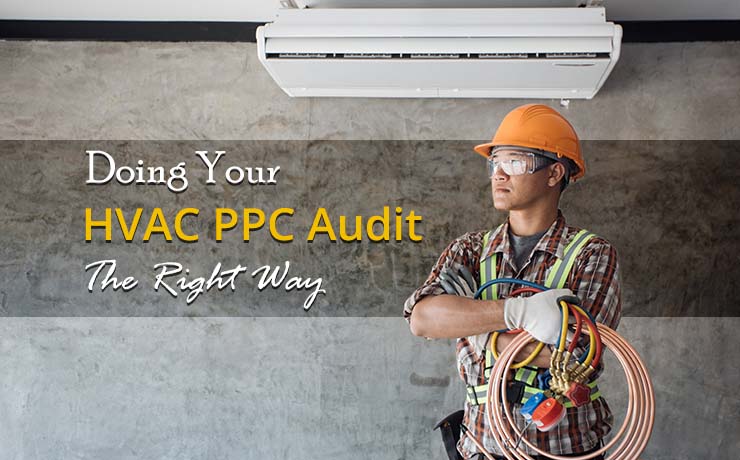
Whether you manage your HVAC PPC campaigns yourself or outsource them, you will have to conduct an audit at least twice annually or even better, quarterly. If red flags pop up at any time such a sudden huge drop in customer engagement, you may want to conduct an audit there and then to identify the problem. However, do you know what steps to take to ensure that your HVAC PPC audit is done the right way? Many people get overwhelmed looking at all the options on the dashboard when they start their PPC audit. That is perfectly natural.
In this article, we share with you a step-by-step guide on doing your HVAC PPC audit the right way.
Think Back to Your Starting Goals
Before starting your PPC audit, think back to when you first launched the ads. What were your goals back then? This is important because performance measurement will be based on these goals. Have your goals changed or evolved along the way? If so, keep them in mind when evaluating data to avoid any misinterpretation or miscalculation. Depending on how long you have been running your ads and how far back you want to obtain insights from, you may choose to look at a date range starting from 3 months and going all the way back to a year or more.
In addition, you may be running numerous separate campaigns. As a HVAC business, you likely offer a variety of services, from installing heating and cooling systems to repairing ductwork and more. You may notice that each campaign has different goals and maybe even target audiences. That is fine, but always keep those specific details in mind when working on each campaign.
Ad Delivery: Reaching the Right Audience at the Right Time
As a business in the HVAC industry, it makes sense that you can only offer your services within a specific radius. Therefore, you will not want to waste time and money on targeting customers outside of this range. To ensure the highest possible ROI, you will want to ensure that ads are targeted at customers most likely to convert. This can include:
- Geo-targeting: Including some areas and excluding others.
- Scheduling: When you analyze your sales and conversion data, you will almost definitely see a pattern. Which days of the week and which time of day result in more conversions? Maybe weeknights are when most customers click for your ad – if so, optimize your ads to show up during these times.
- Device: Is there a big difference between conversion rates across devices? Are more users landing on your ad through mobile? You may want to consider a device-specific campaign if desktops are not bringing in a significant percentage of conversions, for instance.
- Language: Most HVAC businesses throughout the United States will run their ads in English. However, you may want to stop and think if the area you live in has a large demographic of people who are bilingual or speak another language. If so, consider experimenting with running your ad in another language.
- Search Terms and Keywords: Review your search terms report to determine if there are any keywords you overlooked. Can they be incorporated into one of your existing ad groups? It may also help you discover a negative keyword to add to your list: these are search terms you do not want your ad to show up for.
Of course, you will want to make the most of the money you are spending on marketing efforts. When you discover something that is not working, for instance, a particular area that never converts despite clicking on your ad, it may be time to make changes. This can include reducing the size of the target area or excluding specific areas, adding or removing certain keywords and making some adjustments to scheduling. You may also consider lowering your bid prices if the data points towards doing so.
Adjust Your Bid
Is your PPC ad not performing because it is underfunded? A bid that is too low can result in reduced visibility as well as slower processes of ad optimization and data collection. If that is the case, adjust your bid. It makes more financial sense to spend a higher amount to receive results than spend a sum, however small, and receive nothing in return.
Review Your Keywords
In order for your ads to be relevant to your customers, you need to make use of strategically selected keywords. Keywords need to be segmented based on the services you provide, and each ad group should not consist of more than 20 keywords. If you find that any ad group has more than 20, review them and determine how well the keywords relate to each other. Could any of them be better placed in a different ad group? After all, HVAC businesses offer many related services and it can be easy to overlook an inappropriately placed keyword. When you segment your keywords according to the service they promote, this makes it more likely for your ad to show up in relevant search queries. The result is lower cost per click and higher CTRs and conversion rates.
Do Not Neglect Negative Keywords
Are there any negative keywords that have popped up throughout the course of your campaign? For instance, maybe customers searching for “drink coolers” or “wine coolers” landed on your ad for home cooler systems, bringing up your cost per lead. You will also need to account for singular/plural forms, misspellings and more if you want to exclude them. There are a few different ways you can apply negative keywords:
- Negative broad match: Your ad will not show up if a user types in all the terms of your negative keyword, regardless of its order. Under negative broad match, a search for “coolers wine” will not precipitate your ad to show up.
- Negative phrase match: With negative phrase matches, your ad will not show up when the terms in your negative keyword are typed in the order you specified. This applies even when additional words are included in the search term.
- Negative exact match: Your ad will not show up as long as the negative keyword is typed in the exact order you indicated and with no additional words. However, it may show if additional words are included in the search term.
Track Conversion Rates
The goal of PPC marketing, after all, is to increase exposure and conversion rates at a faster pace than other forms of marketing. It is also crucial in calculating cost per lead, allowing you to deduce whether you need to make changes to your budget. If your conversion rates are not what you would like them to be, you may want to check if each landing page makes use of the most appropriate call to action or conversion tool. Depending on the individual page, this can be an online contact form or a service page.
When tracking conversion, you will want to first decide on a timeframe compatible to your sales cycle. From there, calculate the cost per lead. How much is each lead costing you? Is it cost-efficient? Keep in mind that one customer can convert multiple times, however, they are only counted as one visitor. Which landing pages are bringing in the most conversions? You will need to take into consideration all the above factors and more when conducting a HVAC PPC audit. It all comes down to this: PPC marketing for home service businesses can be incredibly effective in bringing up conversion rates within a short timeframe. As an industry that can only operate more or less within a local radius, it is important that HVAC businesses know the right way to conduct PPC audits.
 Free
Consultation
Free
Consultation Free
Google Ads Audit
Free
Google Ads Audit








